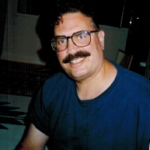Up and Down
William Masters, December 18, 2023
I RIDE ELEVATORS.
To reach my office in downtown San Francisco I take the escalator from the ground floor to the mezzanine. From the mezzanine, I ride an elevator from elevator bank A to the 21st floor. From the 21st floor, I switch to elevator bank B and ride to the 33rd floor on which my office is located. If I arrive in the building between 8:30 and 9:00 AM, multiple stops at various floors extend my ride by six to ten minutes.
I rely on gearless traction electrical thrust to deliver me to work.
To arrive on time, I must also add elevator travel time to my bus commute: eighteen minutes plus twelve minutes equals thirty minutes. Of course, I still add a six to ten-minute wait for the bus which, theoretically, follows its 2016 schedule, but in reality, (with a couple of early morning exceptions) runs on its own maverick schedule based on breakdowns, weather conditions, and driver disposition.
In 1857 my great-grandfather rode in New York City’s first elevator, an Elisha Graves Otis design, and a steam-powered car moved by a system that used a belt-driven winding drum. When great-grandfather arrived back home in Rochester, he was met by the editor and photographer of the Rochester Gazette who took his picture and asked him whether or not he thought he would go to hell for riding in a hoisting device that offended God.
“Only birds and angels have the right to move that high,” the editor proclaimed.
My great-grandfather politely said that angels had a great deal farther to go than five floors. “Elevators will not become a path to reach heaven,” great-grandfather authoritatively replied.
The next day, after his picture and a short interview were published, he became a local celebrity, though shunned by the more pious portions of the religious community until 1873 when a Presbyterian minister from Rochester attended a religious convention in New York City at the Gabriel Arms hotel in which he rode the elevator to his room on the ninth floor.
In my grandparent’s day, every elevator had an operator, usually in uniform and often seated on a polished wooden stool, to run the technological marvel. Men took off their hats inside elevators while most women still wore hats and gloves. No one even considered eating or drinking between floors. At each stop, the operator called out the floor number. Men would automatically step aside to allow the women to exit first.
In my parent’s day, some elevators still had operators who may or may not have worn uniforms. A passenger’s disapproving glance or lifted eyebrow might embarrass a man into removing a hat or prevent him from unwrapping a candy bar. Women still grudgingly followed the nod of a man’s head or the hand gesture signaling permission to enter or exit the elevator.
Today almost all elevators, save the elegant Hotel car located in a major city or express run in a corporate headquarters building, operate as self-service transportation. Still, such elevators often boast richly polished wooden panels, occasionally carved up by a bike messenger or marble inlays adorning polished stainless steel interiors, infrequently marred by the grease pencil of someone wandering around in the building who managed to evade security.
Fashion conspires with bad taste to encourage hat-wearing in elevators while vanity encourages the application of fragrances in amounts far exceeding any limits of propriety, or in some instances, of safety. I personally witnessed a fellow elevator passenger overcome by the fragrance from a perfume while the other passengers merely suffered in silence. I have observed the combination of misplaced hipness and sloth encourages both eating and drinking in elevators.
Repeated exposure to the smells of fast-food lunches carried by passengers has increased my level of olfactory sensitivity enabling me to identify the various brands of fast food while riding the elevator. I can smell the difference between fries from the Scottish fast food joint and fries from the toy box joint; between the cheese used for the nachos from the joint named after Peter Pan’s housekeeper and the cheese used in the stuffed potato from the burger joint named after a reigning monarch.
Tact and consideration for fellow passengers have diminished to a whisper. Completely oblivious to my presence, I overheard one employee pitch to her boss the termination of another employee whose work was consistently careless, causing grief to other employees.
“Have you documented the mistakes?” asked the boss. The other employee shook her head. “Then you can’t terminate her, but if you have the corroboration of other employees you can put her on probation. Ninety-six percent of employees on second probation perform below acceptable standards. Then you can terminate her.”
“She’s African American,” the woman added. The boss shot her a hostile look.
“Then you will have to give her some retraining or switch her around to another job and hope it works. With another wrongful termination suit in this company, I’ll be gone.”
Recently, while on the long ride on elevator A, the young lady next to me was listening to her headphone set. Although turned to the lowest setting, the music sounded so loud that I politely asked her to turn it off while riding on the elevator. She responded with surprising venom, using language that would make a sailor blush, to inform me that I could not abridge her personal rights. I responded that a public space of such small dimensions warranted my request. Still, she refused and stalked off to the 19th floor.
On the following morning, I had an 8 A.M. emergency dental appointment located in the 491 Post Street Medical building. Although my dentist’s office was located on the 13th floor, I hit the 14th-floor button since most buildings do not use the number 13 and skip from 12 to 14 on the numbered floors. These days such methodology derives from habit rather than superstition.
At almost the 11th floor the elevator stopped. The lights went out and then flashed on at a lower wattage. An alarm rang three times. A voice from a speaker on the left panel of the elevator spoke. “Hello, can you hear me?”
I replied that I could.
“My name is Anna.” The woman’s voice continued speaking to me, “Are you OK?” “Please tell me your name.”
“Glen Hanson,” I replied. I complained that I had a toothache and asked her to contact my dentist, Dr. John Noren, and tell him I was stuck in the elevator and would not arrive on time. I laughed out loud.
“We are working on the problem. Please open the panel on the left side of the elevator door and check to make sure a flashlight is there and that it works.” I followed the instructions and replied that it was and it did.
“We have called our elevator person to diagnose and repair whatever the problem is. Can you breathe alright? Is there enough air in the car?”
Before I could respond, I heard a hissing sound. Oxygen blew into the car from somewhere in the right panel. “I am in pain, I said annoyed, “Pain from a toothache, but I can breathe fine. From where is the elevator repair person coming?” I asked trying to create an estimate of how long I might remain here.
“He’s already on his way from Vallejo.”
“What? From Vallejo,” I responded. “Why the hell do you employ someone who lives over 32 miles away and needs a 45-minute drive plus a possible further delay to cross the Bay Bridge for emergencies in a San Francisco elevator?”
There was a period of silence pierced by a deep-sounding female voice, authoritative and condescending, unquestionably from some management type, most likely the archetypal Human Resource person.
“The building has a contract with this person.”
“In Vallejo?” I repeated. Does the City permit you to have your elevator rescue person live that far away?”
“We can alert the fire department,” the deep voice responded.
“Yes, please do that immediately and I want you to alert the Bay Area Regional Elevator Company which is the brand and installer of this elevator. I read this information from a panel: We are proud that you are riding in a ‘Regional Elevator Company product’ I want you to do this now. Got it?”
There followed a few minutes of silence during which I pondered how many times a day I had to step into an elevator. So many other City residents lived and worked 10, 20, or more stories above the ground. Yet I seldom thought about the complicated electromechanical systems that moved me up and down. Five or six minutes stranded alone in an elevator eleven stories up in a downtown building in San Francisco, while I waited for the emergency elevator repair person to arrive, seemed far longer than waiting the same minutes standing in line at a Starbucks or Pete’s coffee house. My mind wandered to thoughts of a Tower of Terror-like plunge into the subbasement below, followed by blunt trauma and death.
“I am here, Mr. Hanson.”
“Don’t let them shuffle you away Anna.” I had decided that I should treat Anna as a friend. “As soon as the elevator person arrives, I want to speak to him. I don’t care if you don’t have an emergency maintenance contract with him. And I want to speak to the Fire department person as soon as he arrives. Tell your boss that I marked the time I made the request to her and if she delayed calling them…”
“Mr. Hanson, the fire department has arrived. I am putting him on the line now.”
“Hello, Mr. Hanson. My name is Jack Stock, the emergency fire department elevator response person (EFDERP). I am waiting for the elevator people to arrive. I just talked to them on my cell. They are on their way using a police escort moving their vehicle through the traffic like an ambulance. All I can do is to give you first aid, should you need it.”
I tried to stop looking at my watch. I pictured a police car with the siren on, clearing the way for the elevator company’s emergency response vehicle (ERV). I was sitting on the elevator floor and imagined the ERV had collided with a California Street cable car stopped by a car stalled on the cable car tracks. I sneezed. The continual rush of fresh, cool air into the elevator cabin had reduced the temperature, and although I felt beads of perspiration dripping down my forehead, I felt chilly. Or maybe I was going into shock?
Nonsense. Suddenly I remembered my toothache. “I am in pain,” I complained. “Remember I am here because I have a toothache.”
“Mr. Hanson, this is Ed Forester from the elevator company. We are checking the mechanism right now. In just a few minutes we will find a solution and get you out. Trust me.”
“OK. Ed. You’ve got my trust and I hope you brought the luck and the know-how.”
“I’m still here,” said Anna. We called in a psychologist to speak with you as soon as we get you out after the fire department person examines you to confirm you don’t need medical attention.”
“But I do need medical attention. Remember, I have a toothache and I am still in pain,” I lied. My toothache pain had temporarily stopped, getting ready, no doubt, to abscess and then make me pass out from renewed pain.
About five minutes later Ed spoke to me through the elevator’s speaker. “This is Ed, Mr. Hanson. We will have you out in two or three minutes. Sit down on the floor.
“I am already on the floor.”
“Good, you will feel the elevator make three short drops on its way to the tenth floor. On the tenth floor, the doors will automatically open. Don’t try to get up. Stay on the floor and we will remove you out ourselves.”
The elevator moved down and abruptly stopped, then repeated the move twice. The door to the tenth floor opened and Ed and Jack lifted me off the floor and sat me in a waiting wheelchair.
“Thanks to you guys,” I said. An old, grey-haired woman appeared. “Anna?” I asked.
Then I requested the use of a bathroom, skipped the psychologist interview session, and rode another elevator to my dentist’s office. Later, after I had been redirected to an endodontist on the 15th floor and endured the first part of a root canal, I called Ed on my cell using the number on his card and asked him to tell me what problem he had found.
“Mr. Hanson, the problem with your elevator was that it had an old, leaky single bottom jack placed directly in the ground. Those in-ground cylinders are prone to corrosion and electrolysis which can lead to small leaks or catastrophic failure of the entire hydraulic system. The elevator you took did not have the update in the elevator safety code requiring that replacement cylinders have double bottoms, which minimizes serious safety and environmental risks. The building will receive a citation, pay a large fine and, of course, replace the old with the new system. Between you and me, I think some inspectors got paid off. The building management hired us to replace the old system, and make all the necessary California State five-year load tests, etc. to ensure that your elevator can lift its rated load at its rated speed. These tests also ensure the integrity of the hydraulic system, including the cylinder, oil line, and valve and tank unit.”
I called the San Francisco Span, (as compared to the morning paper that chronicled the news and the evening paper that examined the news more closely) to report the incident. After fact-checking my story, the paper sent a reporter to my home for an interview. I related my misadventure to the Span’s ace reporter, Anita Skeeter, the older sister of Rita Skeeter, reporter, and gossip columnist for The Daily Prophet. To my surprise, the next day the Span ran this front-page story.
ELEVATOR SCARE IN DOWNTOWN MEDICAL BUILDING
By Anita Skeeter
How safe are you riding in an elevator? Do you defy the odds each day when you step into an elevator car that may have skipped its mandatory scheduled testing? Do you have enough life insurance to protect your family should the elevator fail and plunge to the bottom of the building resulting in your premature death and necessitating a closed coffin at your funeral? How many bribes have building managements dished out to inspectors willing to look the other way?
Yesterday on May 7th, 46-year-old paralegal Glen Hanson, aching from the pain of a toothache, pushed the 14th-floor button for his dentist appointment in the 491 Post Street Medical Building. On the way up, the elevator failed and stopped between the 10th and eleventh floors. For thirty-two minutes, Mr. Hanson trembled with fear and suffered from pain when he found out that the elevator emergency response person was coming from Vallejo, 32 miles away, and at least a 45-minute car trip. How can the city of San Francisco allow such a preposterous backup period? When interviewed, management admitted that the further away the EFDERP lived, the cheaper the rate! Finally, the building management succumbed to pressure from the San Francisco Fire Dept. and contacted the elevator company for assistance. Only after the elevator company arrived, was the problem located and Mr. Hanson rescued. Building management refused to discuss alleged shortcomings in elevator maintenance discovered by the elevator company.
Will you be the next victim?
(No one else contributed to this article)
The day after the article appeared, the San Francisco supervisors (in a precedent-setting single vote) unanimously passed an ordinance requiring building management to update elevator protocols and employ emergency response persons located within the downtown area.
Local radio stations and T.V. networks picked up on the story, usually mentioning that for once, the overheated, yellow rhetoric of the San Francisco Span might have done some good: inspectors examined hundreds of old elevators across the country mandating any deficiencies discovered to be brought up to current safety standards. The article was picked up by the AP and the UP and reprinted across the nation in Los Angeles, San Diego, Chicago, New York, Atlanta, and Philadelphia newspapers, not to mention various other local T.V. network news stations.
Building managements all over the country updated their elevator maintenance schedules and reviewed their protocols to confirm that all mandatory testing had been conducted and necessary changes made to meet current building codes for elevators.
Finally, the subject and story faded away but were not forgotten. Afterward, the results of the article were always referred to as The Hanson Effect, and for a while, I was a hero in my own city. But, alas, every hero eventually becomes a bore.
You may also like

Eyes of the Beholden
Unspoken desires linger in the shadows of a teacher's life, revealed through art

LOST
Bessie's odyssey through stormy nights, lost love, and secret graveyards unfolds with haunting beauty in "Lost" by Sandra Dennis.

Water Rising
Amidst a flood, a woman grapples with the past, and confronts the consequences in this haunting narrative of resilience.

Book Review: White Nights by Urszula Honek
The debut short story from Polish writer Urszula Honek, White Nights, is akin to reading an account of a haunted place – one that is beautiful and devastating in equal

Beyond the Surface: The Multifaceted Lives of ‘American Fiction’
In essence, "American Fiction" and the experiences it draws from remind us that we are indeed more than the sum of our parts.

Beyond the Surface: The Multifaceted Lives of ‘American Fiction’
The narrative of “American Fiction” unfolds with a dual focus: it not only scrutinizes the unique pressures faced by Black creatives but also delves into the intricate and sometimes tense…

Uncle Bobby’s Funeral
Reluctant family faces the eccentricities of Uncle Bobby's funeral in swampy Chipley.








